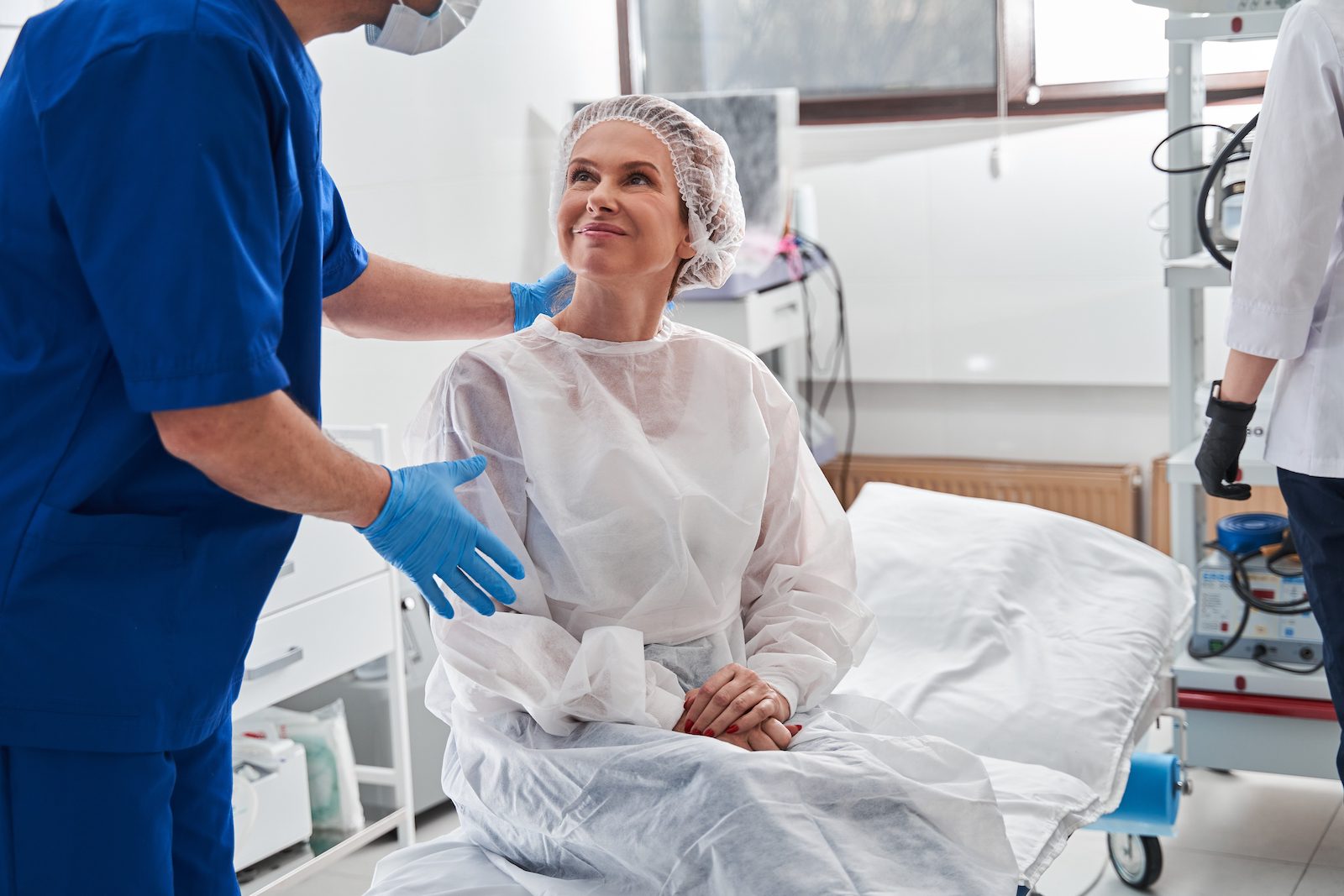Medical Disclaimer: This content is for informational purposes and does not constitute medical advice. Please consult a health care provider prior to starting a new treatment or making changes to your treatment plan.
Inspire sleep apnea treatment is an implantable medical device used to treat obstructive sleep apnea (OSA). People with OSA have episodes of reduced or stopped airflow due to blockage in their upper airway. OSA is the most common type of sleep apnea, and estimates suggest that about 10% to 30% of adults experience it.
Obstructive sleep apnea is often underdiagnosed. It estimated that 50%-75% of people with OSA symptoms haven’t been tested for sleep apnea. OSA can cause you to snore or wake up frequently, and left untreated, it can more seriously impact overall health, increasing the risks of hypertension and heart disease. It can also cause excessive daytime sleepiness, which may increase safety risks and accidents or simply make it hard to function. Luckily, several treatment options are available to treat sleep apnea.
The most common OSA treatment is continuous positive airway pressure (CPAP) therapy, in which pressurized air flows through a mask to keep the airway open. However, CPAP doesn’t work for everyone, which is where alternatives like Oral Appliance Therapy (OAT) with a mandibular advancement device, or Inspire come in. All three of the first line therapies, CPAP, OAT, and Inspire treat OSA by helping move the tongue out of the airway.
We cover how Inspire sleep apnea treatment is used to treat OSA and who might want to consider it.
How Does Inspire Sleep Apnea Treatment Work?
Inspire sleep apnea treatment uses nerve stimulation to improve breathing during sleep. It monitors breathing patterns and stimulates specific nerves to keep the airway open. It’s intended to treat obstructive sleep apnea and can’t be used for central sleep apnea, which involves brain signals rather than throat muscles. There are three main components of the Inspire sleep apnea device.
- Implantable pulse generator (IPG): The battery that powers the Inspire sleep apnea device is sealed in the IPG. It is connected to the stimulation lead and sensing lead, connecting and timing the nerve stimulation with breathing. It’s implanted in the upper chest.
- Stimulation lead: The cuff electrodes in the stimulation lead deliver gentle nerve stimulating electrical currents that cause the base of the tongue to move forward and open the upper airway.
- Sensing lead: A pressure sensor is used to detect breathing and supports the device’s timing.
The device comes with two remotes. After the Inspire sleep apnea device is implanted, a doctor uses the physician remote control to program the setting for the nerve stimulation. Those using Inspire also have a remote control to turn the treatment on before going to sleep and off after waking.
How Is the Inspire Sleep Apnea Device Implanted?
The Inspire sleep apnea device is surgically implanted by a trained surgeon. Before the operation, you may undergo a sleep study, medical and surgical consultation, or endoscopy to screen for surgical eligibility. On average, the outpatient surgery takes about 2.5 hours and involves two small incisions. Most people can go home the same day or within a few days after surgery. The batteries for the medical device need to be replaced every 7 to 10 years.
During the operation, the stimulation lead is placed on the hypoglossal nerve, which is a nerve that directs the muscle responsible for tongue movement. The surgeon also implants the sensing lead to detect breathing patterns and the implantable pulse generator to send nerve pulses. A month after the surgery, you’ll visit your doctor to activate your device, and then you can use it at home while you sleep.
How Successful Is Inspire?
Inspire has been shown to be clinically effective for treating moderate to severe sleep apnea in people who don’t respond to or tolerate CPAP therapy. Before Inspire was approved by the U.S. Food and Drug Administration (FDA) in 2014, 126 people participated in a clinical study to demonstrate that the treatment was effective in treating OSA.
After 12 months of Inspire sleep apnea treatment, more than half of the clinical study participants saw their OSA symptoms improve. The frequency of breathing disruptions at night decreased to fewer than 20 events per hour.
People who underwent Inspire sleep apnea treatment in the study reported having less daytime sleepiness, and also noted increased well-being.
What’s the Difference Between CPAP and Inspire?
Both CPAP therapy and Inspire are used to treat obstructive sleep apnea, but CPAP is the standard treatment option. Inspire sleep apnea therapy is an alternate treatment option for people who found CPAP failed to eliminate their OSA, thought it was too uncomfortable, or were unable to use it consistently.
For CPAP treatment to work, it must be used every time a person sleeps. But it can be challenging for some to get used to sleeping with the CPAP mask and machine. Light sleepers may be unwilling to continue with CPAP treatment due to sleep disruptions. Patients who don't take well to CPAP may prefer using Inspire to treat their sleep apnea.
Another major difference between both treatments is how they function. CPAP is a machine that uses continuous air pressure to keep the upper airways open during sleep. In contrast, the Inspire sleep apnea treatment uses nerve stimulation to keep the airway muscles open during sleep. The Inspire sleep apnea device is surgically implanted into the body, and CPAP treatment is administered through a mask that is worn while sleeping. CPAP equipment requires daily cleaning and regular maintenance.
Are There Any Risks With This Treatment?
Clinical studies have demonstrated that Inspire sleep apnea treatment is safe, though all surgeries carry risks. Incidents of serious complications related to the surgical procedure were less than 2%. In rare cases, extreme discomfort may require another operation to reposition the device.
The most common side effects from the implant procedures are minor sore throat, pain at the incision sites, and aching muscles.
Possible complications include:
- Nerve damage and blood vessel damage
- Infection
- Skin irritation
- Pain or swelling at the implant area
- Tongue soreness and difficulty moving tongue
- Dry mouth
- Headaches
- Coughing, choking, or speech-related issues
- Insomnia
It is also important to note that getting this device implanted makes you ineligible for certain types of MRI tests, which can interfere with future diagnostic testing.
Individual risks vary, and this may not be the right treatment for everyone. Speak with your doctor when considering the risks and benefits of the Inspire sleep apnea treatment.
Is Inspire Approved by the FDA?
Inspire sleep apnea therapy is approved by the FDA. Inspire Upper Airway Stimulation (UAS) therapy was initially FDA-approved in 2014 for people 22 and older with moderate to severe obstructive sleep apnea. However, in 2020, the FDA extended its approval to include people 18 and older.
Am I Eligible for Inspire?
Only a subset of sleep apnea patients are eligible for Inspire sleep apnea treatment. It’s only available with a doctor’s prescription, and there are a variety of eligibility requirements.
- Obstructive sleep apnea: People eligible for Inspire must have moderate to severe obstructive sleep apnea, but they can’t have a completely blocked upper airway.
- CPAP history: Only people who haven’t had success with CPAP therapy or find it difficult to continue with the therapy can use the Inspire treatment for sleep apnea.
- AHI: Eligible patients must have an apnea-hypopnea index (AHI) — a measure of apnea events per hour — that ranges from 15 to 65.
- Medical history: People with medical conditions that impede neurological control of the upper airway aren’t eligible to use Inspire. Neither are people who are pregnant or plan to be. In addition, those who have pronounced or unusually large anatomy, such as large tonsils, that prevent upper-airway stimulation may not be eligible.
- Age: People younger than 18 are not eligible to use Inspire sleep apnea treatment.
- Accessibility: People must have the ability or assistance needed to operate the remote used to turn the Inspire sleep apnea device on and off.
- Weight: People with a BMI of 32 or higher may not be ideal candidates for Inspire sleep apnea treatment due to the effect obesity can have in reducing the effectiveness of upper airway stimulation.
When to Ask Your Doctor About Inspire
Speak to a doctor if you have obstructive sleep apnea, think you might meet the eligibility requirements for Inspire, and have not had success with CPAP therapy. A trained medical provider will be able to help you determine if Inspire is right for you.
Depending on the severity of your sleep apnea, your doctor may first focus on addressing risk factors. Losing weight and making certain lifestyle changes, like reducing alcohol intake, can help control obstructive sleep apnea. Your doctor may also recommend a noninvasive method such as a sleep apnea oral appliance to keep your upper airway from closing during sleep. If none of those methods work, your doctor might explore surgery as an option. In some cases, it may be beneficial to combine Inspire surgery with Oral Appliance Therapy for better results.
Untreated OSA can have adverse effects. You should speak to a doctor if you have any of the following symptoms:
- Waking up tired
- Choking, gasping, or snorting during sleep
- Feeling sleepy during the day
- Snoring
- Needing to take frequent naps
Will Inspire Be Covered by My Insurance?
The Inspire sleep apnea device is covered by most major insurance companies, including Medicare. If Inspire isn’t specifically covered, it may be approved based on medical necessity on an individual basis. Inspire sleep apnea therapy is also available to veterans through the Federal Supply Schedule.









